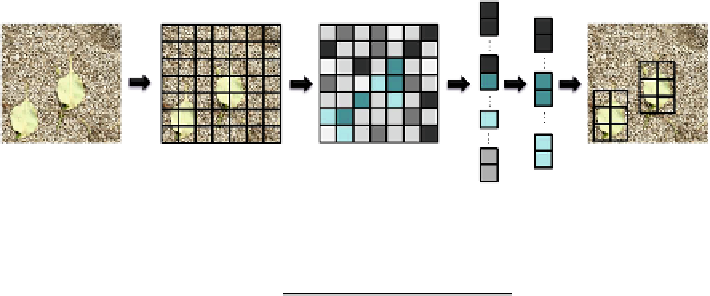Image Processing Reference
In-Depth Information
Fig. 6.3
Block-based copy-move forgery detection: 1. preprocessing; 2. overlapping blocks;
3. feature vectors; 4. sorting; 5. detection of similar blocks, 6. detection of CMF
2
2
d
=
(
x
f
1
−
x
f
2
)
+(
y
f
1
−
y
f
2
)
(6.3)
7. The detection image is generated by marking all remaining pairs of blocks. Some
simple post-processing can be applied to remove small, falsely detected areas in
the image (for example, morphological opening).
6.3.2
Possible Feature Vectors
Defining an appropriate feature set is a common problem in block-based methods,
because features have to yield similar results for duplicated blocks despite the trans-
formation of the copied area or applied post-processing methods. Different sets of
feature vectors for block-based CMFD have been proposed [5].
One of the first approaches used quantized frequency coefficients of the Discrete
Cosine Transform (DCT) [9] as features. Thanks to the properties of DCT, it gives
good results in cases of added noise, compression, and retouching. A similar ap-
proach is presented by Bashar et al. [2], where the coefficients of a Discrete Wavelet
Transform (DWT) using Haar-Wavelets was introduced. Bayram et al. [3] recom-
mended using the Fourier-Mellin Transform (FMT) for generating feature vectors.
Popescu and Farid [17] computed Principal Component Analysis (PCA) to re-
duce the feature set size. This representation is robust to compression and adding
of noise, but any transformation of the copied area (for example, scaling, rotation)
would affect the eigenvalues. Later this approach is expanded by dividing every
block into 4 sub-blocks using the Discrete Wavelet Transform (DWT) [12]. A sim-
ilar approach to [17] was proposed in [11], where Singular Value Decomposition
(SVD) was used.
Luo et al. [15] introduced features based on the intensity of pixels in blocks. The
first three values of the feature vectors included the average of the red, blue and
green color components. The rest of the feature vector was defined by dividing of
the block into 2 equal parts in 4 directions and calculating the ratio of each part's
intensity with respect to the intensity of the whole block. Bravo-Solorio et al. [4]
used the same three components as in the previous method with the addition of the
entropy of a block. A similar approach is presented in [14] where every block was










Search WWH ::

Custom Search